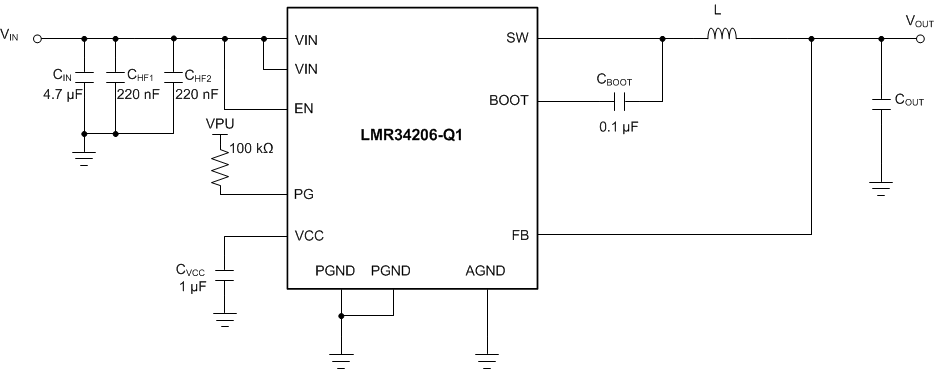SNVSBA8A May 2019 – October 2019 LMR34206-Q1
PRODUCTION DATA.
- 1 Features
- 2 Applications
- 3 Description
- 4 Revision History
- 5 Device Comparison Table
- 6 Pin Configuration and Functions
- 7 Specifications
- 8 Detailed Description
- 9 Application and Implementation
- 10Power Supply Recommendations
- 11Layout
- 12Device and Documentation Support
- 13Mechanical, Packaging, and Orderable Information
Package Options
Mechanical Data (Package|Pins)
- RNX|12
Thermal pad, mechanical data (Package|Pins)
- RNX|12
Orderable Information
9.2 Typical Application
Figure 18 shows for the LMR34206-Q1. This device is designed to function over a wide range of external components and system parameters. However, the internal compensation is optimized for a certain range of external inductance and output capacitance. As a quick start guide, Table 3 provides typical component values for a range of the most common output voltages.
 Figure 18. Example Applications Circuit (Fixed Output)
Figure 18. Example Applications Circuit (Fixed Output) Table 3. Typical External Component Values
| ƒSW (kHz) | VOUT (V) | L (µH) | Nominal COUT (rated capacitance) (1) | Minimum COUT (rated capacitance) (2) | CIN |
|---|---|---|---|---|---|
| 2100 | 3.3 | 6.8 | 2 × 15 µF | 1 × 15 µF | 4.7 µF + 2 × 220 nF |
| 2100 | 5 | 10 | 2 × 15 µF | 1 × 15 µF | 4.7 µF + 2 × 220 nF |
(1) Optimized for superior load transient performance from 0 to 100% rated load.
(2) Optimized for size constrained end applications.